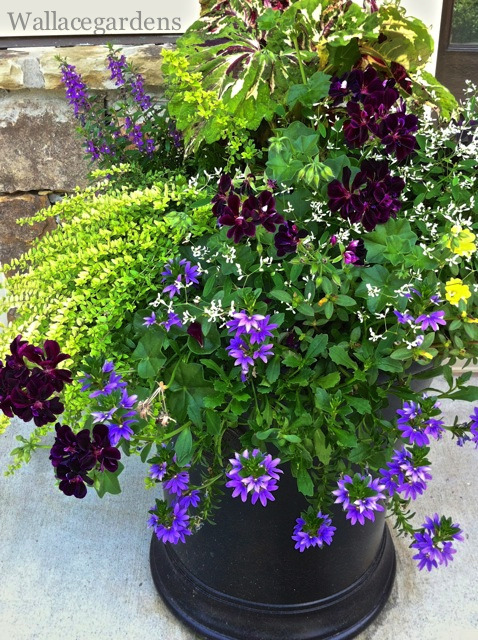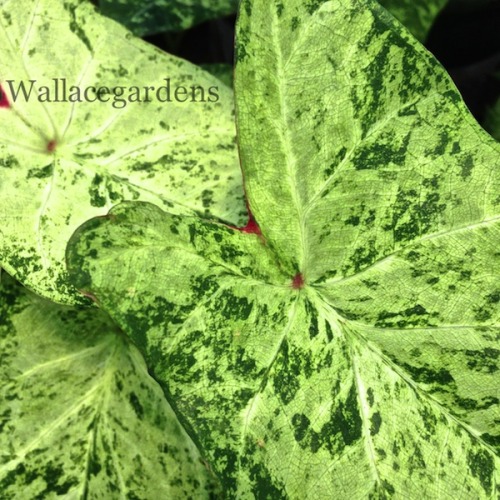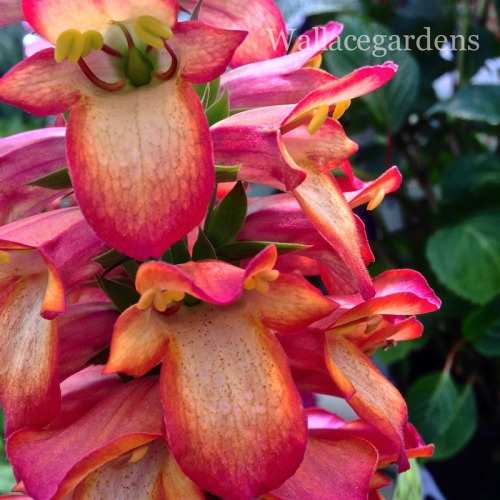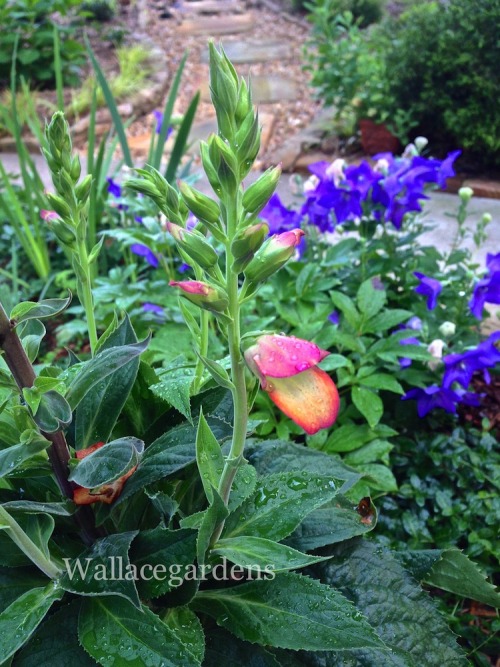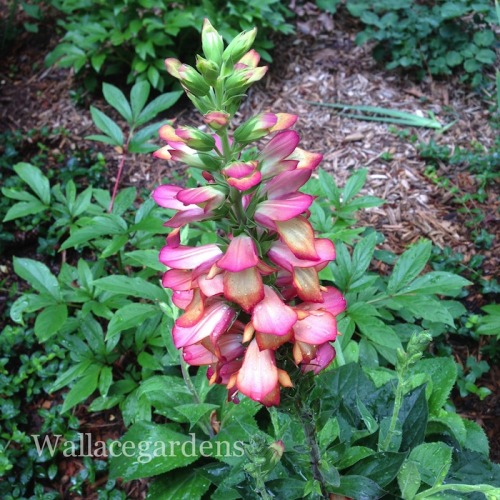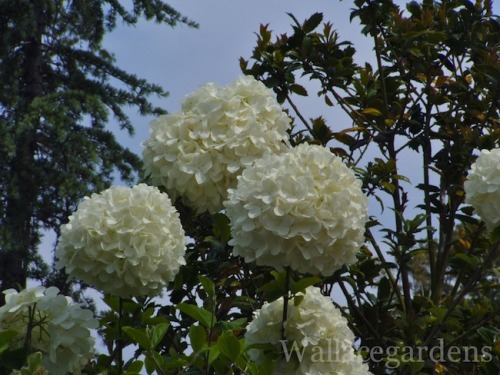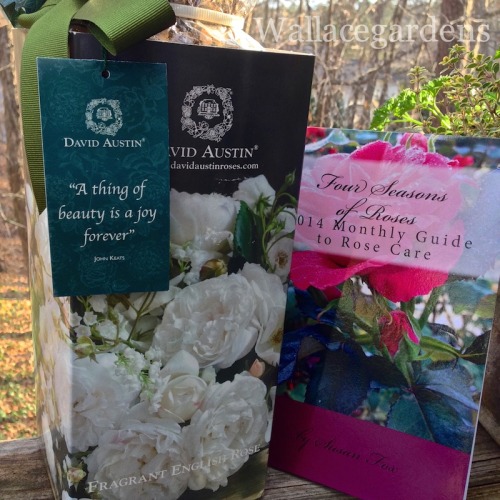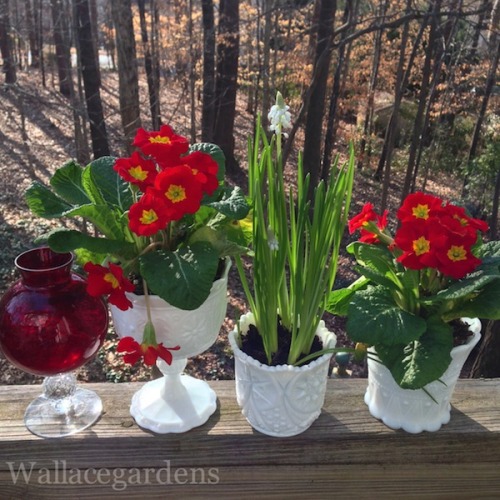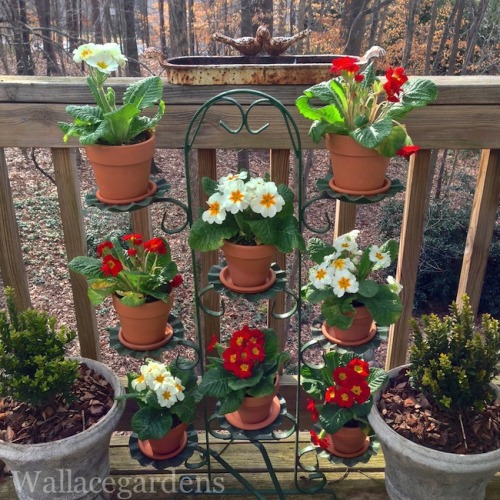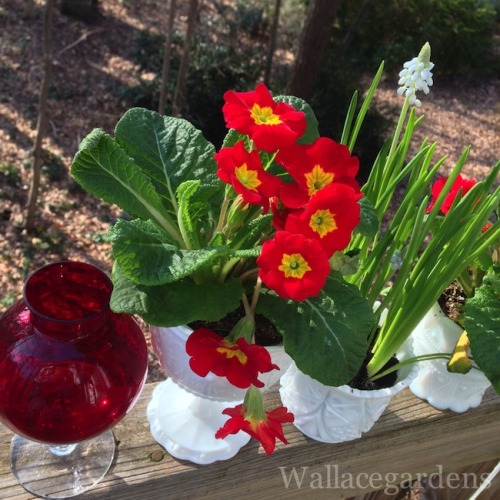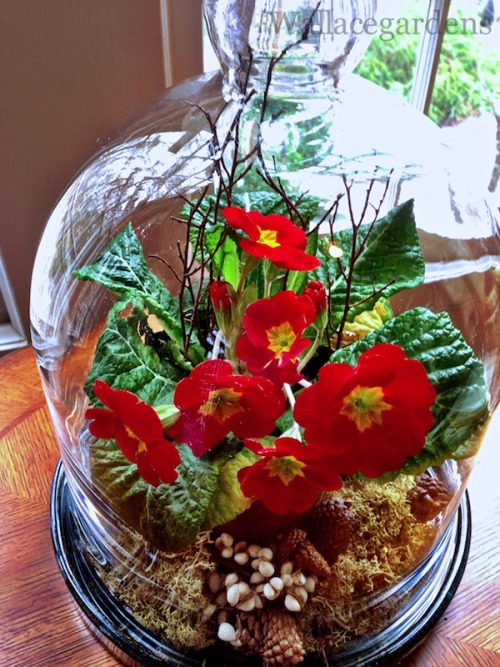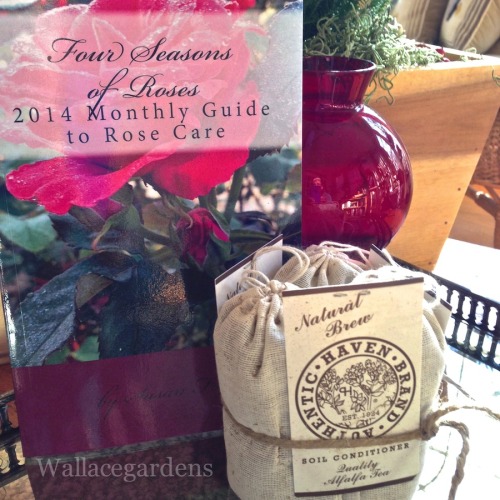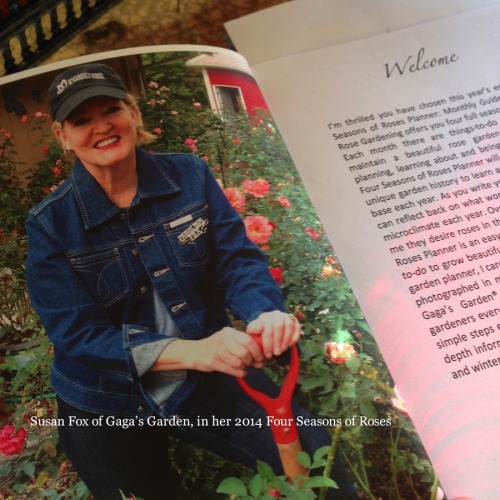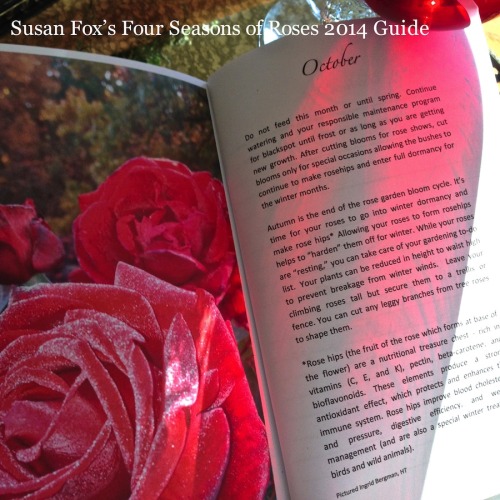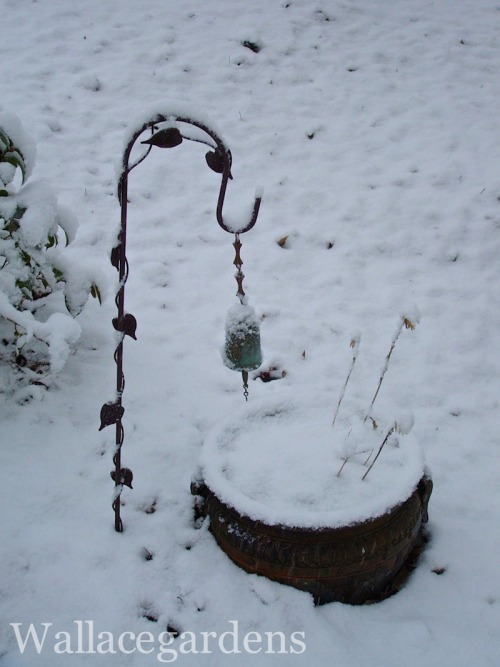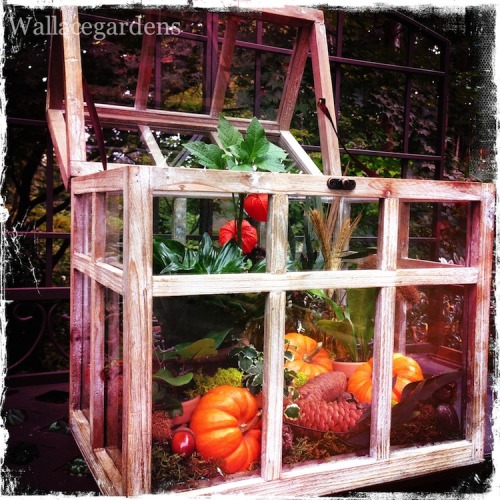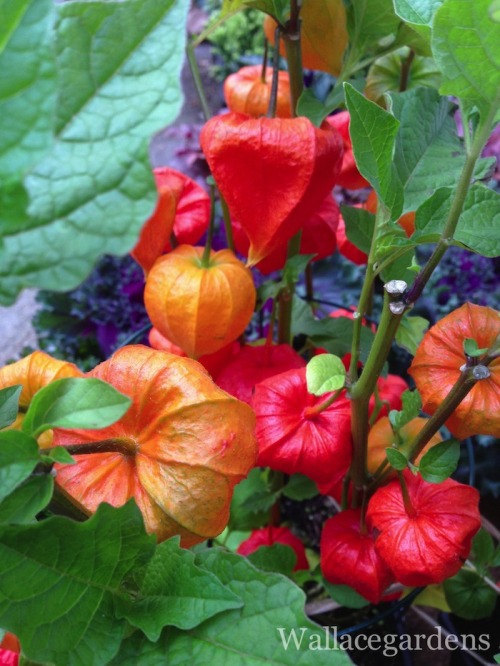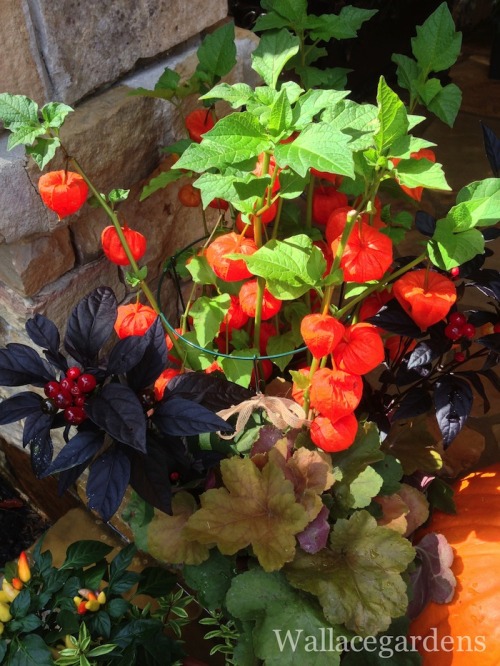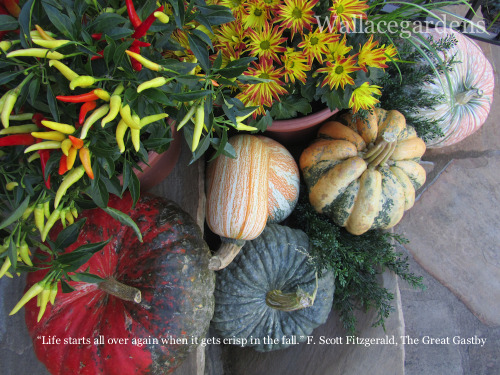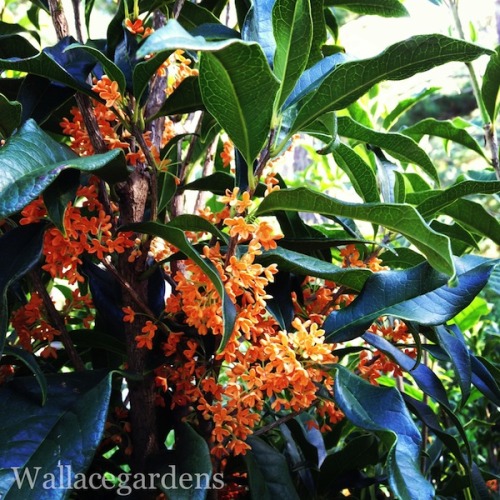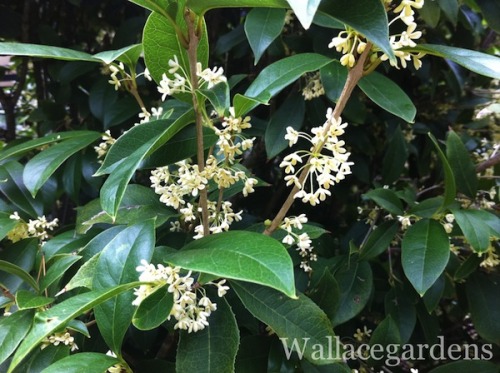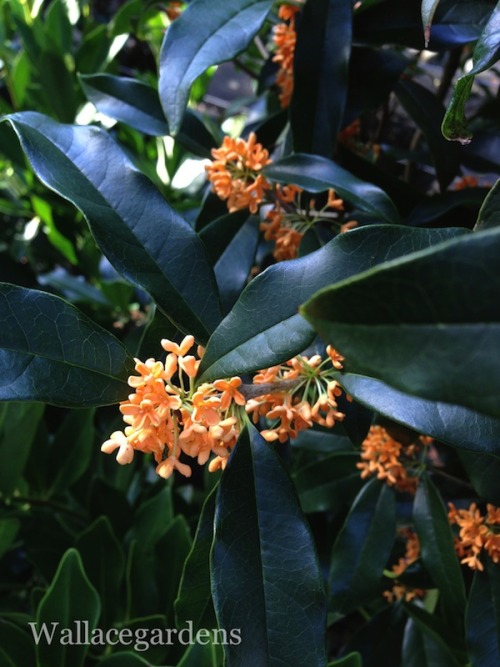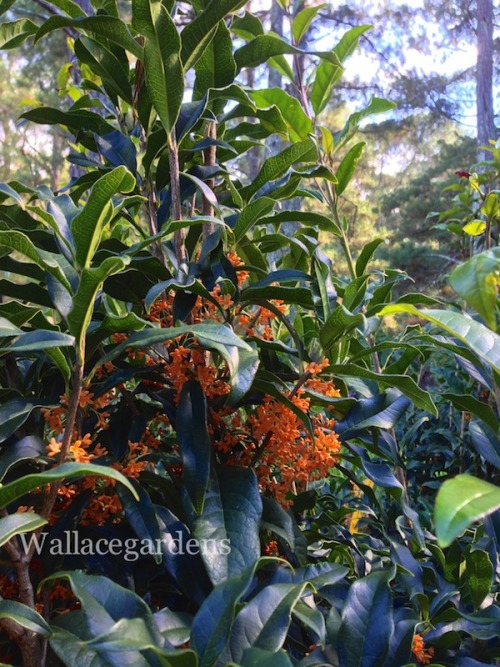#wallace gardens
Available while supplies last: Caladium ‘Frog in a Blender.'
FromSpalding Bulb Farms, Florida: “If you are looking to add a unique flare to your garden then be sure to include any of these beauties in your order."
One might assume they were inspired by Dan Akroyd’s SNL skit: Super Bass-O-Matic '76.
Post link
Postcards from the Hedge.
A Foxglove with Lipstick?
Imagine the perfect non-stop summer bloomer with enormous impact all by itself, which is also deer proof. Meet Digiplexis ‘Illumination Flame,’ a cross between Digitalis purpurea (foxglove) and Isoplexis canariensis (Canary Island foxglove). This new hybrid blends the qualities of both plants, thanks to the efforts of Charles Valin, plant breeder at Thompson & Morgan. It received the Best New Plant Award at the Royal Horticultural Society Chelsea Flower Show (2012), as well as the Greenhouse Grower’s Award of Excellence in 2013.
Multiple side branches emanating from this bushy basal-branched shrub produce flame-colored flower stalks all summer long, even into the fall. Because the plants are sterile, they don’t waste energy trying to go to seed, and this results in fast-growing, floriferous shrubs with vibrant, vertical flower stalks to 3’ in height in shades of watermelon, fuchsia and mango. And while that may sound delicious, Digiplexis has the same toxins as its relative, Digitalis, so all parts of the plant are poisonous. If you use the plant in cut flower arrangements, dispose of the water safely because the toxins will seep from the stalks into the water. The foliage may also cause skin irritation, so handle it with caution.
Digiplexis can be used in seasonal color beds as a backdrop to other annuals, or grown in large containers. It will take part shade to full sun, and blooms from April until the first frost.
Post link
Planter Ideas: Thriller, Filler, and Spiller.
“Editors note: It’s fun to hear our lead designer, Brooks, talk about décor he’s designed. About the above Bombay® Luxembourg Planter he says: ‘It was inspired by French planters, little planters with legs called cachepots. We wanted something elegant and used an animal, and a lion was regal and Bombay in a European way.’
"That’s great but how does it do in a garden? We asked horticulturist and garden artisan Nancy Wallace to try it out. What she did yielded amazing insights into creating a stunning container garden. Thriller, filler, spiller… Take it away, Nancy!"
Read more at Bombay Outdoors.
Post link
April is National Gardening Month, and here in Atlanta, it is arguably the prettiest month of the year. Everything is in bloom, and it can be positively head-spinning to pick out favorite landscape plants, so let’s discuss a couple of favorite deer proof plant materials.
Viburnum macrocephalum (Chinese Snowball) is one of my favorite small landscape trees. It tolerates full sun and part shade, and once established, it’s fairly drought tolerant. Many people mistake this tree for a hydrangea, because the flowers are similar. However, unlike hydrangeas, viburnums are deer resistant. I’ve never seen one of these trees damaged by wildlife, and just look at the size of those flower heads. Use a specimen tree like this as a focal point in your landscape, so that when April arrives, all eyes are upon it.
While we are on the subject of deer proof plant materials, and favorite April-bloomers, let’s talk about herbaceous peonies. These long-lived perennials are tough as nails, they thrive here in the Atlanta-metro area, and are drought tolerant once established. Choices include fully-double peonies, or single-petal varieties. The doubles are very fragrant, but they may topple over without support, especially in heavy spring rains. My personal favorites are the single-petal varieties, like ‘Red Emperor’ and 'Krinkled White’ because they withstand heavy down pours. The two most important things to remember about growing peonies is (1) make sure they have good drainage, and (2) keep the “eyes” (or the “crown”) of the plant at ground level during the winter (and don’t bury them in mulch). Peonies will bloom better when nipped by cold weather, so they appreciate the extra winter exposure. Garden centers often carry peonies when they are in bloom, so it’s easy to choose your favorite color. For best results, plant in groups of three, and expect peonies to multiply over time, providing years of spectacular blooms. If you want to start peonies from bare roots (“tubers”), wait until fall to plant them. There are many fine mail order sources for bare root peonies, and it’s a much more cost-effective way to expand your perennial collection.
Post link
Bare Root Roses. It’s time to start gathering those roses in winter, bare root roses!
And to get everyone off to another great rose season, Wallace Gardens is giving away a copy of the Four Seasons of Roses 2014 Monthly Guide to Rose Care by Susan Fox,including one bare root rose: David Austin’s English Rose ‘Winchester Cathedral.’ You’ll have Susan’s advice, right at your fingertips when you receive this rose, pictured above in a bare root box with Susan’s calendar. To enter: you must have a mailing address within the Continental United States. See below for instructions to enter.
The American Rose Society awarded Susan with its Presidential Citation “for Promoting the Rose and Rose Education Via Social Media,” and her photo of the Julia Child Rose is included in the 2014 ARS Calendar for the month of July. This is a woman who knows her roses.
'Winchester Cathedral’ is a large, fragrant white-blooming rose. Mature size will depend upon where you live, but expect it to grow to at least 4-5’ tall and wide, with masses of white flowers that continue at regular intervals throughout the summer. David Austin describes the scent as a “Light Old Rose with hints of honey and almond.” What garden wouldn’t be improved by such summer fragrance?
Instructions to enter: all you have to do is “like” and/or comment on the ’Winchester Cathedral’ photo on Pinterest. You must have a mailing address within the Continental United States. The winner will be selected at random and announced on TUESDAY, MARCH 4, 2014. So hop to it!
Post link
Herb Garden Design with Essential Fruits and Vegetables
Before planning an edible garden, think about the purpose of the garden first. These four window boxes were designed so that the client can easily open her windows and make a selection, or water everything from the convenience of her kitchen. We chose all my client’s favorite herbs and edible flowers: garlic chives, marigolds, parsley, several varieties of basil, creeping thyme, cilantro, and even a couple of strawberry plants.
Some herbs are also “perennials” and will last year round, while others (like basil) are seasonal. Group seasonal items together so that they are easily replaced with something else once their growing season is complete.
When replacing plants, don’t forget to replenish the soil, especially if you are planting in window boxes or containers. Valuable nutrients pass through containers quickly, so fresh soil amendments will ensure that the new plants get off to a great start.
Theme gardens are popular right now. Consider grouping herbs and vegetables together in a raised bed for cooking purposes. If you love Asian cooking, you might want to grow lemongrass, Thai basil, Vietnamese coriander, Chinese eggplant, and dwarf pepper plants (like ‘Baby Belle’). A great way to introduce children to the concept of gardening is to grow something they will also consume. Create a “Lemonade Garden” with all the plants you might use to make fresh lemonade: pineapple mint, orange mint, basil, cucumbers, and lemongrass. Plant a Meyer lemon tree, dwarf blueberry bushes, and strawberries in containers to complete the Lemonade Garden. Don’t forget to make ice cubes with the blueberries and strawberries for the lemonade.
Get creative. Did you know you can regrow many herbs and vegetables from your own garden, or re-root favorite edibles from the farmers market (celery and mint, for example)? Mother Earth Living provides a great how-to, HERE. Many of these can be started indoors on a sunny window ledge, and then transplanted outside after all danger of frost has passed.
Post link
Happy Valentine’s Day.
Make your own: start with one snow storm. Add items from the horticulture apothecary, such as dried rose buds, deer moss, primrose, preserved greenery, tallow berry, all spice, winter berry, fern fronds, lenten roses, pine cones, assorted winter flower buds.
Send to someone you love.
Post link
An ice storm is on its way. This, after two polar vortexes in January and a two-inch snowfall that paralyzed Atlanta’s roadways for 24 hours. Thank goodness for primroses (Primula vulgarism) - just in time for an icy, snow-bitten Valentine’s Day.
It’s still too early for spring bulbs to appear from beneath the frozen tundra, so I brought home a few primroses from the local garden center to brighten an otherwise grim growing season. I dressed up an old vintage plant stand with terra cotta pots and filled them with primroses. Then I tucked a couple of plants into milk glass vessels that I keep on hand for various flower projects. The snow-white milk glass is such a pretty contrast to plant materials, and the primroses are no exception. For a tabletop centerpiece, I placed a pretty red primrose under a garden cloche for Valentine’s Day. What better way to spend the next two weeks, than under the influence of primroses?
Because primroses like cool temperatures and moist soil conditions, they are an easy flower to grow this time of year. The garden doesn’t offer a lot of color in February, so the first burst of spring usually comes in the form of primroses. As the garden starts to break out of winter, group primroses in planters with violets and pansies, all of which are edible flowers if you grow them organically (I use an organic cow manure tea from Authentic Haven Brand to keep my primroses blooming over a long period of time). Add organically-grown flower petals to salads, pasta dishes, or desserts for subtle, colorful flavors from the garden. Freeze the petals in ice cube trays for fruity beverages, or dry them to use in tea, but introduce them sparingly to guard against possible allergic reaction.
“Primrose” comes from Medieval Latin: prīma rosa, or “first rose.” They are my first flowers every spring.
Post link
How about a garden giveaway? What a lovely way to start the new year! The dead of winter is a perfect time to plan a garden, so here’s a little gift to get you started.
I’m giving away a copy of Susan Fox’s brand new guide: Four Seasons of Roses 2014 Monthly Guide to Rose Care … along with the added bonus of a 3-pack of organic Alfalfa Tea from Authentic Haven Brand Natural Brew, to help grow your roses more beautifully than ever. To enter the giveaway, you must have a shipping address in the United States or Canada, and you must “like” or comment on this photo on Pinterest.
Susan is one of the most gracious and generous gardeners I know, and is always willing to share her secrets to growing roses with the rest of us. “Roses are easy, people can be difficult,” and Susan proves that point with her tips in the new 2014 guide, filled with colorful photographs of roses she took in her rose garden. You can read about her journey to write the guide on her blog.
The American Rose Society awarded Susan with its Presidential Citation “for Promoting the Rose and Rose Education Via Social Media,” and her photo of the Julia Child Rose is included in the 2014 ARS Calendar for the month of July.
You can find Susan on twitter, @gagasgarden, or on her blog, Gaga’s Garden when she isn’t taking care of her roses.
Post link
Jan. 3, 2014. Yesterday, a few folks were questioning, or were curious about, the necessity of watering container gardens, and the urgency with which I was addressing the task. (I garden in Georgia, Zone 7B.) On January 3, 2014, Able Assistant and I hand-watered 83 out of the 92 weekly container gardens I maintain, by accessing clients’ laundry rooms, kitchen and bar sinks, and even bath tubs (the outside spigots were all frozen solid) in preparation for next week’s temperatures which are predicted to drop to 5 degrees on Monday, and 15 degrees on Tuesday.
So, let’s talk about Advective Freezes. An “advective freeze” is also known as a wind borne freeze, and it occurs when a large air mass sweeps into an area (most often from northern regions), accompanied by a drastic drop in temperature. The warmer air is rapidly replaced by frigid air, usually within hours. Advective freezes tend to last longer than other freezes, making it all the more important to protect plant materials, especially container-grown plants or newly-installed landscape materials. Survivability of plant materials will be dictated by how cold it gets, and how long the freeze lasts. Sadly, even by following the steps below, there is no real guarantee against plant death under these conditions.
What can you do? Here are some suggestions.
(1) Watering is a method of freeze protection, and should be done several hours before a freeze. The roots absorb the water, and help protect plants from cold winds and prolonged freezes. Container-grown plants are exposed to winter elements over all surface areas, making them more susceptible to damage than landscape materials. Start filling up watering cans and get those planters watered (as well as newly installed landscape materials if there hasn’t been any recent rainfall). Because outside spigots are likely to be frozen, this means carting watering cans in and out of the house. It can be done.
(2) You can’t “cover” everything in a landscape, but you can protect prized plant materials or plants that are borderline cold-hardy. I use porous coverings, like flannel fitted sheets, which wrap easily around shrubs, window boxes, and container gardens (burlap is another alternative). If it’s windy, you may need safety pins or clothes pins to keep the sheets in place. Cover the plants before it gets dark to trap some of the remaining daytime air inside the covering. Move planters and containers closer to the house, against a wall, or group them together in a protected area, and then cover with a flannel sheet for the night.
(3) Normally, winter is a great time to prune ornamental trees. However, all winter pruning should be delayed until several days after an advective freeze has passed, and a return to normal temperatures has resumed.
(4) If you have access to bales of pine straw, the needles can be strewn around the base (root systems) of susceptible plant materials which are prone to such freeze conditions (hydrangeas, for example, are known to freeze to the ground in severe weather).
Good luck, and stay warm out there!
Post link
Physalis alkekengi (Chinese Lantern)
This unusual plant is a member of the potato family, Solanaceae (which also includes tomatoes, peppers, and eggplants). “Physalis” is from the Greek “a bladder,” a reference to the inflated calyx (sepals of the flower). The flower pods, or lanterns, contain a berry where the seeds are located. Because it spreads by colony-forming rhizomes, it is considered invasive in many parts of the country. Here in Georgia (specifically Zone 7B) it is most commonly used as a fall annual for autumn planters because it combines beautifully with all the colors of fall. Use caution if setting Physalis out into the landscape in a planter, as its roots can easily escape and take hold in the yard.
To dry the lanterns for winter floral arrangements, simply cut the stems off at ground level when the lanterns reach their peak color and remove the leaves. Hang them right side up to dry in a dark, protected location with good air circulation.
Growing Physalis is similar to growing tomatoes, which may explain its sudden popularity in garden centers. Started from seed, the plants will grow in much the same way as tomatoes, with the fruit (lanterns) maturing mid to late summer, along with late-summer garden tomatoes.
This plant is best grown as an outdoor ornamental, because the immature fruits are considered poisonous to children and pets. For information about toxicity, refer to: Lampe, K. F., McCann, M. A. 1985. AMA Handbook of poisonous and injurious plants. American Medical Assoc. Chicago, Ill., USA. 432 pp.
To keep these plants in spectacular form through the Thanksgiving weekend, they are fed a diet of organic compost tea, from Authentic Haven Brand.
Post link
It’s October, and if you’ve noticed something sweet in the air, it just might be this beautiful fall-blooming shrub: Osmanthus fragrans var. aurantiacus, the Tea Olive (or Sweet Olive).
The dense branches are massed with orange blossoms that have a citrus, peach-like fragrance, so place this near a deck or patio where it will be noticed. Tea Olives work well as a screen or hedge, and take to pruning well. With large dark green leaves, the Tea Olive will reach a height of 10-12 feet (and more) without pruning, depending on location. This particular variety is more cold hardy than the species, tolerating temperatures down to the single digits (Clemson Univ. Coop. Ext.). Tolerating a wide range of horticultural conditions, Tea Olives grow well in full sun to medium shade (with a slightly more open shape in shadier locations). Deer will not bother Tea Olives.
“Osmanthus” is from the Greek word osma, meaning “fragrant,” and anthos meaning flower. Tea Olives are natives of the Himalayas, China, and Japan. The flowers are used in Asian dishes, tea, and wine (Kew Royal Botanic Gardens).
Here in Georgia, the Sweet Olive was selected as a 2009 Georgia Gold Medal Plant selection. (The white blooming variety is the more common of the species, Osmanthus fragrans.)
Post link


